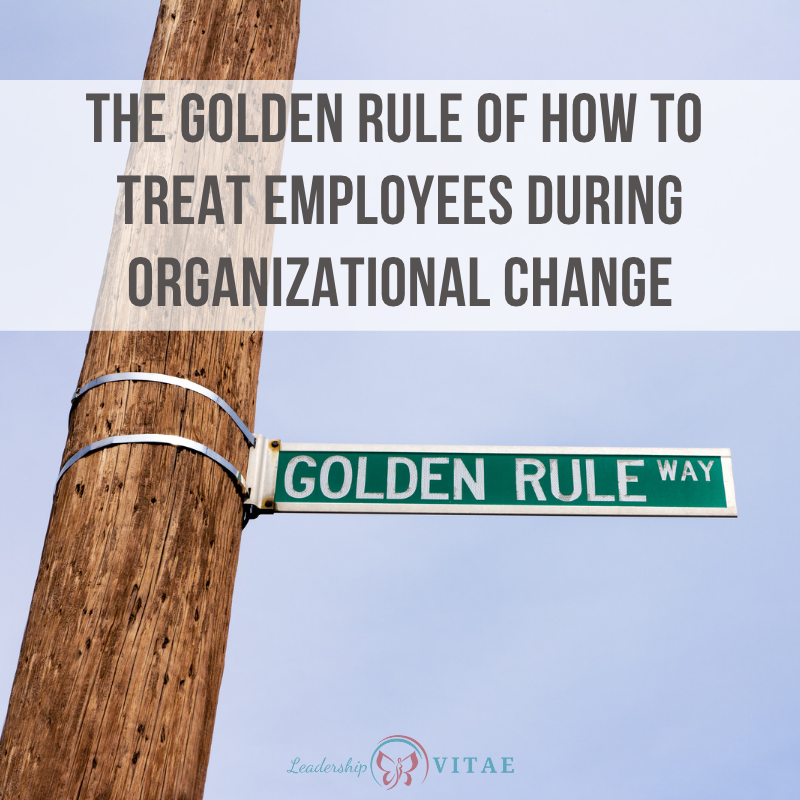
Change is one of life’s constants. If we imagine change as an archetype, it would be Thanos, “I am inevitable.”
In organizations, change is triggered by innumerable events. Maybe a new leader comes in who isn’t attached to decisions and structures made previously. Or is brought in specifically to switch things up. Market conditions or stock price changes. New competitors. Technology advancements. The list goes on.
No matter our role in change, it is disruptive. The closer we are to decision-makers, often the easier our ability to navigate that disruption. However, even if we’re the ones leading the change, it can be a challenge. Now multiply that exponentially the further away from decision-making we are. On the receiving end of change, it can feel like utter chaos.
How leaders treat employees during change can make a huge difference in how it is received. We may be officers of a company and required to follow certain steps. Over the years, I’ve signed many non-discloser agreements that limited what I could do and say during change. However, even with such limitations, there’s one golden rule we can all do our best to follow.
Do unto others as you would have done unto you.
Know the people
Over the years, I’ve been both the leader of change and on the receiving end. When on the receiving end, the best experiences have been the ones where I felt my needs were at least considered.
We may be one of many being impacted by a change. While true, it doesn’t make anyone feel better to know that. The reality is that the same change can impact individuals differently.
It’s not always possible to contemplate change at the individual level, particularly if a change is going to impact hundreds or thousands of people. However, if the change includes options, what’s influencing them? If it’s not the people being impacted, we’ve lost an opportunity.
Knowing our people influences how we think about the options available to us (and them) during change.
One of the most common changes I’ve been through is a reorganization. Over the last decade, I’ve come to expect them every 6-12 months. While disruptive, they present opportunities. Maybe there’s someone ready for a leader position and I can put their name forward as a new organization is being built out. Or take them with me if my job is being redesigned. Someone else might not want that kind of role and I’d be looking for something else more aligned to their interests.
If we don’t know our people, any decisions we make on their behalf run the risk of a poor outcome. It’s better to ask than assume and we may not be permitted to ask when the time comes. Which means regular discussions about someone’s interests and aspirations is key.
Find the opportunities
During change, opportunities abound. Yet they are only opportunities if someone sees them that way. What is exciting to you may be dreadful to me and vice versa.
Over the years, I’ve met numerous leaders who had their own idea of what my path should be. Curating new roles during change, they projected what they would want instead of being curious about what I was looking for. The roles were ideal…for someone else.
If we’ve taken the time to get to know our people and their interests, we can better match opportunities to the right individuals. The reality is that we can either help people get where they want to go, or they will get themselves there.
For some folks, any job is better than no job. However, if there are 3 or 4 options, which one best aligns with the path for that person? If we put folks on a path they don’t want, they’ll go another way. If we co-create a path, they’re more likely to stay on it.
In the case of organizational change, we may be reliant on certain team members to remain part of the team and stay engaged. Maybe we think we MUST have them in a certain role. Knowing up front whether it’s something they’d want, with a path to get to where they want to go, is going to result in a much better outcome. If we just slot them in a job they don’t want but we need them in, with no consideration for their desires, we’re likely to lose them and jeopardize what we need done.
Communication
When it comes to change management, there’s nothing more important than communication. Unfortunately, the ability to communicate may be hampered, depending on the nature and sensitivity of the change.
Prioritizing communication before change is key. We can start with regular development and career pathing discussions. Get to know our people as humans with individual wants and needs. These insights can influence our decision-making when we find ourselves unable to ask directly.
During change, we can advocate for communication where it seems appropriate. I’ve negotiated conversations with key individuals as part of a change plan because of their criticality in the new organizational structure.
Often in change, organizations focus on the “why” for the company. There should be one, no doubt. The reality is that we as humans can’t care about that until we understand the why for ourselves. What is happening to us and is it a good or bad outcome? If our needs have been considered and we understand how this change aligns to our career path, then not only can we receive the company’s why, we can embrace and help move it forward.
Ultimately, that’s our goal as change leaders. To get everyone moving in the same direction towards a new outcome. That’s difficult to do when everyone is following their own path. By knowing the person, finding a best fit, and communicating effectively, we can create a joint outcome where we are more likely to find success together.
* * *
How else might you center team members during change? What advice would you offer a change leader on how to help their teams navigate the uncertainty of change? Please share your thoughts in the comments below.








